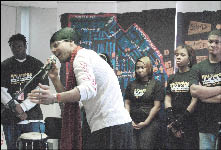 |
|
Street-level diplomacy: Fanon Hill and his Youth Ambassadors pound the Baltimore pavement to develop and promote ideas to help the community. Photo: Safe and Sound Campaign |
Baltimore
(410) 625-7976
http://www.safeandsound.org
Objective: Perform ground-level organizing efforts for the Safe and Sound Campaign, an organization dedicated to ensuring that the city’s youth have the opportunity to grow up safe and healthy and to reach their full potential.
In a Nutshell: Youth ambassadors educate themselves on public budget processes and policies and help Safe and Sound formulate ideas to improve Baltimore communities. YA members perform and speak at public events while also using those forums to share policy ideas with the public and solicit feedback.
Over the years, the ambassadors have conducted more than 100 street-corner speak-outs to seek community input, made presentations at legislative sessions and budget hearings and performed at Artscape, a popular Baltimore summer festival.
Where It Happens: The ambassadors keep an office at the Safe and Sound Campaign’s Baltimore City headquarters, but most of the work takes place on street corners, at block parties, in churches and at City Hall.
When It Began: In 1995, through its Urban Health Initiative, the Robert Wood Johnson Foundation issued a challenge to five U.S. cities to take 10 years, $10 million dollars, and the best intellectual and technical assistance the foundation could provide to develop a local movement to improve the health and future prospects of each city’s children. In 1996, the Safe and Sound Campaign was created to carry out that mission in Baltimore.
Who Started It and Runs It: A cross-section of citizens started the campaign under the leadership of the Baltimore Community Foundation and the Associated Black Charities. Hathaway Ferebee has been the executive director of the campaign since its inception. YA was created in 1996 and has served more than 500 youth. Fanon Hill is the community organizer in charge of the YA program. The program uses three college interns and 12 adult volunteers, known as Medicine Wheel members, who support ambassadors during their outreach efforts.
Obstacles: The main problem has been the evolutionary nature of the campaign and the changing demands and opportunities for the YA effort. For instance, Hill said that in light of the recession, it is hard to find individuals willing to fund initiatives that would provide treatment and therapy for youth. “The political landscape is more interested in spending money on incarcerating people,” he said. The size of the Youth Ambassador program varies from its highest number of 300 to its most lean of 12. Now there are 125 Youth Ambassadors citywide, Hill said.
The other challenge is coordinating the schedules of youth coming from different schools and varied home environments.
How They Overcame It: To address the evolving nature of the Campaign, the YA program remains a flexible initiative that adheres to its core principles and designs its activities, size and schedules depending on the goals of the campaign at a given time. The ambassadors are attempting to persuade elected public officials and community members to increase funding for new opportunities for young people, such as internships and recreation.
Cost: The annual budget is approximately $40,000. Youth Ambassadors are paid the minimum wage.
Who Pays: Though the Robert Wood Johnson Foundation provided the challenge that launched the program, the initial grant for YA came from the Fund for Populations at Risk at the Baltimore Community Foundation, and further support has come from the Annie E. Casey Foundation, the Charles Crane Family Foundation and the Baltimore Community Foundation. Youth ambassadors receive in-kind donations from Golden Bridge International Youth Program, the University of Baltimore’s Black Student Union, Maryland Institute & College of Art’s drawing department, Goucher College, Joy for Healing and Mothers In Charge-Baltimore.
Youth Served: Approximately 500 young people have been involved with Youth Ambassadors since 1996.
Youth Turn-On: They learn how to hold public officials and community members accountable for creating and protecting public policies that serve the best interests of youth.
Youth Turn-Off: Developing some adults’ ideas about the power of youth resiliency can be a protracted and draining effort. “Unfortunately, too many adults expect the worst from youth when youth are in possession of the best,” said Hill.































